Lesson 5.1: Powering the Cell: Cellular Respiration and Glycolysis
Lesson 5.1: Powering the Cell: Cellular Respiration and Glycolysis
Lesson Objectives
Clarify the relationship between breathing and cellular respiration.
Trace the flow of energy from food molecules through ATP to its use in cellular work.
Compare cellular respiration to burning.
Analyze the chemical equation for cellular respiration.
Briefly describe the role of mitochondria in producing ATP.
Compare cellular respiration to photosynthesis.
Show how carbon and oxygen atoms cycle through producers, consumers, and the environment.
Recognize that glycolysis is the first and most universal of three stages in cellular respiration.
Explain why biologists consider glycolysis to be one of the oldest energy production pathways.
Describe how some of the energy in glucose is transferred to ATP in the cytoplasm, without oxygen.
Introduction
You know that humans deprived of oxygen for more than a few minutes will quickly become unconscious and die. Breathing, also known as respiration, is essential for human life, because the body cannot store oxygen for later use as it does food. The mammalian respiratory system, shown in Figure 5.1 features a diaphragm, trachea, and a thin membrane whose surface area is equivalent to the size of a handball court - all for efficient oxygen intake. Other forms of life employ different types of respiratory organs: fish and aquatic amphibians and insects flaunt gills, spiders and scorpions develop ”book lungs,” and terrestrial insects use an elaborate network of tubes called tracheae, which open via spiracles, as shown in Figure 5.2 and Figure 5.3. A constant supply of oxygen gas is clearly important to life. However, do you know why you need oxygen?
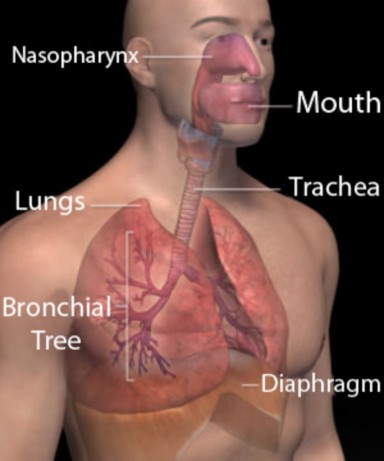
Many people would answer that oxygen is needed to make carbon dioxide, the gas exhaled or released by each of the respiratory systems listed above. However, CO2 is waste product. Surely, there is more to the story than just gas exchange with the environment! To begin to appreciate the role of oxygen inside your body, think about when your breathing rate increases: climbing a steep slope, running a race, or skating a shift in a hockey game. Respiration rate correlates with energy use, and that correlation reflects the link between oxygen and energy metabolism. For this reason, the chemical reactions inside your cells that

Figure 5.2: Spiracles in this Indian Luna Moth (Actias selene) caterpillar connect to a system of internal tubes (tracheae) which carry oxygen throughout the animal’s body. (20)
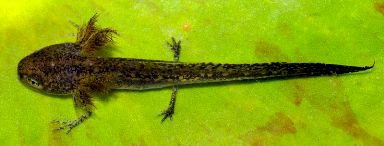
Figure 5.3: Gills in this alpine newt larva, Triturus alpestris, bring blood close to an extensive surface area so that the newt can absorb dissolved oxygen gas from its watery habitat. (15)
consume oxygen to produce usable energy are known as cellular respiration. This chapter will introduce you to the overall process of cellular respiration, and then focus on the first stage, which by itself does not require oxygen.
An Overview of Cellular Respiration
Another way to think about the role of oxygen in your body - and a good starting point for understanding the whole process of cellular respiration - is to recall the last time you sat by a campfire (see below figure) and noticed that it was ”dying.” Often people will blow on a campfire to keep it from ”dying out.” How does blowing help? What happens in a campfire?
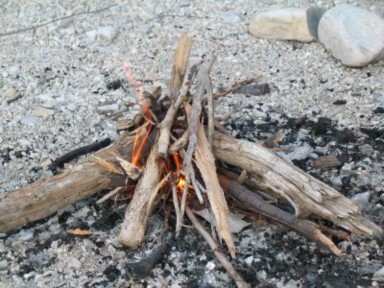
You know that a fire produces light and heat energy. However, it cannot ”create” energy (remember that energy cannot be created or destroyed). Fire merely transforms the energy stored in its fuel – chemical energy – into light and heat. Another way to describe this energy transformation is to say that burning releases the energy stored in fuel. As energy is transformed, so are the compounds that make up the fuel. In other words, burning is a chemical reaction. We could write our understanding of this energy-releasing chemical reaction up to this point as:

Now return to what happens when you blow on a fire. The fire was ”dying out,” so you blew on it to get it going again. Was it movement or something in the air that promoted the chemical reaction? If you have ever ”smothered” a fire, you know that a fire needs something in the air to keep burning. That something turns out to be oxygen. Oxygen gas is a reactant in the burning process. At this point, our equation is:

To complete this equation, we need to know what happens to matter, to the atoms of oxygen, and to the atoms of the fuel during the burning. If you collect the gas rising above a piece of burning wood in an inverted test tube, you will notice condensation - droplets appearing on the sides of the tube. Cobalt chloride paper will change from blue to pink, confirming that these droplets are water. If you add bromothymol blue (BTB) to a second tube of collected gases, the blue solution will change to green or yellow (Figure 5.5), indicating the presence of carbon dioxide. Thus, carbon dioxide and water are products of burning wood.
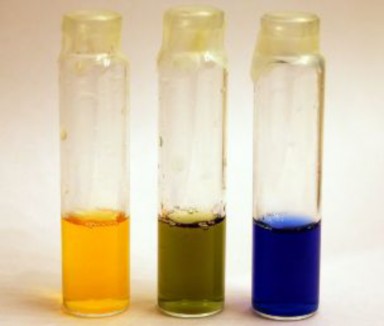

Now we know what happened to those oxygen atoms during the chemical reaction, but we need to be sure to identify the sources of the carbon atoms in the CO2 and of the hydrogen atoms in the water. If you guessed that these atoms make up the wood fuel – and nearly all fuels we burn, from coal to propane to candle wax to gasoline (hydrocarbons!), you have solved the equation completely. Overall, burning is the combining of oxygen with hydrogen and carbon atoms in a fuel (combustion or oxidation) to release the stored chemical energy as heat and light. Products of combustion are CO2 (oxidized carbon) and H2O (oxidized hydrogen). Or in symbols,

Return to the fate of the oxygen gas you breathe in and absorb. Recall that we related breathing rate and oxygen intake to energy use. Burning consumes oxygen as it releases stored chemical energy, transforming it into light and heat. Cellular respiration is actually a slow burn. Your cells absorb the oxygen carried by your blood from your lungs, and use the O2 to release stored chemical energy so that you can use it.
However, releasing energy within cells does not produce light or intense heat. Cells run on chemical energy – specifically, the small amount temporarily stored in adenine triphos- phate (ATP) molecules. Cellular respiration transfers chemical energy from a ”deliver- able” fuel molecule – glucose – to many ”usable” molecules of ATP. Like oxygen, glu- cose is delivered by your blood to your cells. If ATP were delivered to cells, more than 60,221,417,930,000,000,000,000,000 of these large molecules (which contain relatively small amounts of energy) would clog your capillaries each day. Pumping them across cell mem- branes would ”cost” a great deal of energy. A molecule of glucose contains a larger amount of chemical energy in a smaller package. Therefore, glucose is much more convenient for bloodstream delivery, but too ”powerful” to work within the cell. The process of cellular respiration uses oxygen to help transfer the chemical energy from glucose to ATP, which can be used to do work in the cell. This chemical equation expresses what we have worked out:
![]()
As with burning, we must trace what happens to atoms during cellular respiration. You can readily see that when the carbon atoms in glucose are combined with oxygen, they again form carbon dioxide. And when the hydrogen atoms in glucose are oxidized, they form water, as in burning. You can detect these products of cellular respiration in your breath on a cold day (as water condensation) and in the lab (BTB turns yellow when you blow into it through a straw). The equation:
![]()
This accounts for the energy transfer and the carbon, hydrogen, and oxygen atoms, but it does not show the ”raw materials” or reactants which build ATP. Recall that the energy temporarily stored in ATP is released for use when the bond between the second and third phosphates is broken. The resulting ADP can be recycled within the cell by recombining it with inorganic phosphate (Pi).
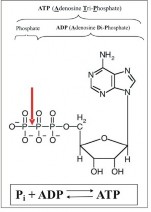
Now you should be able to see that the source of energy for re-attaching the phosphate is the chemical energy in glucose! Materials cycle and recycle, but energy gets used up and must be replaced. That is the key to understanding cellular respiration: it is a ”recharging of the batteries” - ATP molecules – which power cellular work. How many ATP can be made by harnessing the energy in a single glucose molecule? Although this number varies under certain conditions, most cells can capture enough energy from one molecule of glucose to build 38 molecules of ATP. Our equation becomes:
![]()
This equation for cellular respiration is not quite complete, however, because we can easily mix air and glucose sugar (even adding ADP and Pi) and nothing will happen. For the campfire, we indicated above the arrow that a necessary condition was a spark or match to start the reaction. A spark or match would damage or destroy living tissue. What necessary condition initiates the slow burn that is cellular respiration? Recall that enzymes are highly specific proteins which ”speed up” chemical reactions in living cells. More than 20 kinds of enzymes carry out cellular respiration! If you also recall that membranes within organelles often sequence enzymes for efficiency, as in chloroplasts for photosynthesis, you will not be surprised that a specific organelle, the mitochondrion (Figure 5.6), is also a necessary condition of cellular respiration - at least in eukaryotes.

Within each eukaryotic cell, the membranes of 1000-2000 mitochondria sequence enzymes and electron carriers and compartmentalize ions so that cellular respiration proceeds effi- ciently. Mitochondria, like chloroplasts, contain their own DNA and ribosomes and resem- ble certain bacteria. The endosymbiotic theory holds that mitochondria, too, were once independently living prokaryotes. Larger prokaryotes engulfed (or enslaved) these smaller aerobic cells, forming eukaryotic cells. Many prokaryotes today can perform cellular respira- tion; perhaps they and mitochondria have common ancestors. Their expertise in generating ATP made mitochondria highly valued symbionts.
Including these necessary conditions and balancing numbers of atoms on both sides of the arrow, our final equation for the overall process of cellular respiration is:
![]()
In words, cellular respiration uses oxygen gas to break apart the carbon-hydrogen bonds in glucose and release their energy to build 38 molecules of ATP. Most of this process occurs within the mitochondria of the cell. Carbon dioxide and water are waste products. This is similar to burning, in which oxygen breaks the carbon-hydrogen bonds in a fuel and releases their chemical energy as heat and light. Again, carbon dioxide and water are waste.
If you have studied the process of photosynthesis, you’ve probably already noticed its sim- ilarity to the process of cellular respiration. Both are processes within the cell which make chemical energy available for life. Photosynthesis transforms light energy into chemical en- ergy stored in glucose, and cellular respiration releases the energy from glucose to build ATP, which does the work of life. Moreover, photosynthesis reactants CO2 and H2O are products of cellular respiration. And the reactants of respiration, C6H12O6 and O2, are the products of photosynthesis. This interdependence is the basis of the carbon-oxygen cycle (Figure 5.7), which connects producers to consumers and their environment. At first glance, the cycle merely seems to show mitochondria undoing what chloroplasts do; but the cycle’s energy transformations power all the diversity, beauty, and mystery of life.
An excellent animation demonstrating cellular respiration can be found at the following web site:
http://videos.howstuffworks.com/hsw/10323-matter-and-energy-glycolysis-and-cellula htm
Glycolysis: A Universal and Ancient Pathway for Making ATP
When was the last time you enjoyed yogurt on your breakfast cereal, or had a tetanus shot? These experiences may appear unconnected, but both relate to bacteria which do not use
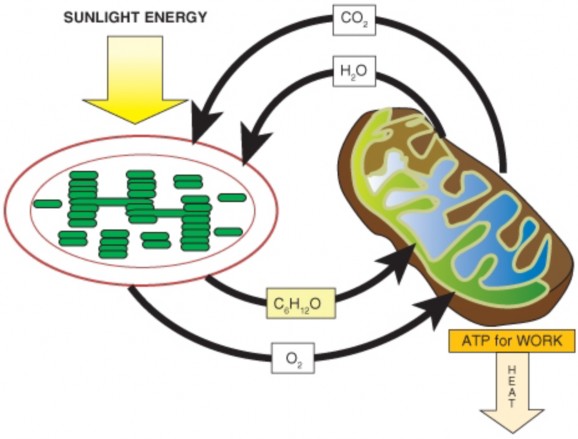
oxygen to make ATP. In fact, tetanus bacteria cannot survive if oxygen is present. However, Lactobacillus acidophilus (bacteria which make yogurt) and Clostridium tetani (bacteria which cause tetanus or lockjaw) share with nearly all organisms the first stage of cellular respiration, glycolysis (Figure 5.8). Because glycolysis is universal, whereas aerobic (oxygen- requiring) cellular respiration is not, most biologists consider it to be the most fundamental and primitive pathway for making ATP.
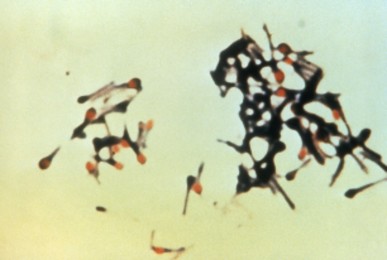
Figure 5.8: Clostridium tetani bacteria are obligate anaerobes, which cannot grow in the presence of oxygen and use a variation of glycolysis to make ATP. Because they can grow in deep puncture wounds and secrete a toxin, which can cause muscle spasms, seizures, and death, most people receive tetanus vaccinations at least every ten years throughout life. (9)
Return to the overall equation for cellular respiration:
![]()
Like photosynthesis, the process represented by this equation is actually many small, indi- vidual chemical reactions. We grouped the reactions of photosynthesis into two stages, the light reactions and the Calvin Cycle. We will divide the reactions of cellular respiration into three stages: glycolysis, the Krebs Cycle, and the electron transport chain (Figure 5.9). In this section, we will explore Stage 1, glycolysis - the oldest and most widespread pathway for making ATP. Before diving into the details, we must note that this first stage of cellular respiration is unique among the three stages: it does not require oxygen, and it does not take place in the mitochondrion. The chemical reactions of glycolysis occur without oxygen in the cytosol of the cell (Figure 5.10).
The name for Stage 1 clearly indicates what happens during that stage: glyco- refers to glucose, and -lysis means ”splitting.” In glycolysis, within the cytosol of the cell, a minimum of eight different enzymes break apart glucose into two 3-carbon molecules. The energy

Figure 5.9: The many steps in the process of aerobic cellular respiration can be divided into three stages. The first stage, glycolysis, produces ATP without oxygen. Because this part of the cellular respiration pathway is universal, biologists consider it the oldest segment. Note that glycogen and fats can also enter the glycolysis pathway. (23)

released in breaking those bonds is transferred to carrier molecules, ATP and NADH. NADH temporarily holds small amounts of energy which can be used later to build ATP. The 3- carbon product of glycolysis is pyruvate, or pyruvic acid (Figure 5.11). Overall, glycolysis can be represented as shown below:
![]()
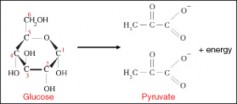
However, even this equation is deceiving. Just the splitting of glucose requires many steps, each transferring or capturing small amounts of energy. Individual steps appear in Figure
![]()
Further Reading / Supplemental Links
Studying the pathway in detail reveals that cells must ”spend” or ”invest” two ATP in order to begin the process of breaking glucose apart. Note that the phosphates produced by breaking apart ATP join with glucose, making it unstable and more likely to break apart. Later steps harness the energy released when glucose splits, and use it to build ”hot hydrogens” (NAD+ is reduced to NADH) and ATP (ADP + Pi ATP). If you count the ATP produced, you will find a net yield of two ATP per glucose (4 produced – 2 spent). Remember to double the second set of reactions to account for the two 3-carbon molecules which follow that pathway! The ”hot hydrogens” can power other metabolic pathways, or in many organisms, provide energy for further ATP synthesis.
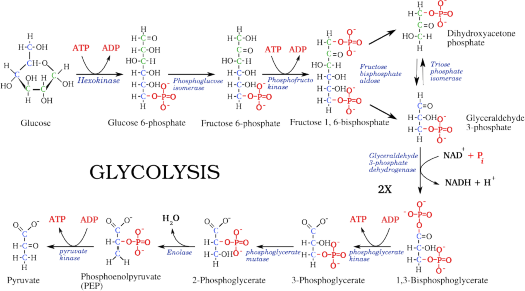
Figure 5.12: This detailed diagram demonstrates that glycolysis ”costs” 2 ATP, but har- nesses enough energy from breaking bonds in glucose to produce 4 ATP and 2 pairs of ”hot hydrogens” (NADH + H+). Note the multiplier (2X) required for the 3-carbon steps. (24)
To summarize: In the cytosol of the cell, glycolysis transfers some of the chemical energy stored in one molecule of glucose to two molecules of ATP and two NADH. This makes (some of) the energy in glucose, a universal fuel molecule for cells, available to use in cellular work
moving organelles, transporting molecules across membranes, or building large organic molecules.
Although glycolysis is universal, pathways leading away from glycolysis vary among species depending on the availability of oxygen. If oxygen is unavailable, pyruvate may be converted to lactic acid or ethanol and carbon dioxide in order to regenerate NAD+, ending anaerobic respiration. Anaerobic respiration is also called fermentation, which we will discuss in a later section.
If oxygen is present, pyruvate enters the mitochondria for further breakdown, releasing far more energy and producing many more molecules of ATP in the latter two stages of aerobic respiration - the Krebs cycle and electron transport chain. We will explore these, too, in a later section.
Lesson Summary
Most organisms need oxygen for a single purpose: to release energy from food for use by cells.
Cellular respiration is a series of chemical reactions which transfer energy from glucose (deliverable or fuel energy) to ATP (usable energy).
Analyzing a campfire can clarify your understanding of cellular respiration. A campfire breaks chemical bonds in wood, releasing stored energy as light and heat; respiration breaks chemical bonds in glucose, releasing stored energy and transferring some to 38 ATP; some energy is lost as heat.
This equation summarizes the process of cellular respiration:

In eukaryotic cells, organelles called mitochondria sequence enzymes and electron car- riers and compartmentalize ions so that cellular respiration proceeds efficiently.
Cellular respiration, in many ways the opposite of photosynthesis, shows the interde- pendence of producers and consumers. Combined, the two equations demonstrate how energy flows and the carbon and oxygen cycle between organisms and environment.
The process of cellular respiration is actually many separate reactions, which can be divided into three stages: glycolysis, the Krebs Cycle, and the electron transport chain.
Review Questions
Why do nearly all organisms die without a constant supply of oxygen?
What source of energy do cells use to build ATP by cellular respiration?
Compare the purpose and energy content of glucose to the function and energy content of ATP; in other words, why do organisms need both kinds of energy-rich molecules?
Compare the process of burning gasoline in your automobile’s engine to the process of cellular respiration in terms of reactants, products, and necessary conditions.
Write out the chemical reaction which summarizes the overall process of cellular res- piration, first in symbols as a chemical equation, and then in words in a complete sentence.
In what eukaryote organelle does cellular respiration take place? Does this mean that prokaryotes cannot carry out the entire process of cellular respiration? Explain.
Compare and contrast cellular respiration and photosynthesis.
Diagram the carbon-oxygen cycle which connects producers, consumers, and their en- vironment. (P = producer, C = consumer).
List the three stages of cellular respiration, and contrast the first stage with the other two in terms of distribution throughout the living world, location within the cell, and use of oxygen.
Summarize the overall process of glycolysis, following both carbon atoms and chemical energy.
Martin Hoagland, Bert Dodson, and Judith Hauck, Exploring the Way Life Works: The Science of Biology. Jones and Bartlett Publishers, Inc., 2001. Chapter 3: ”Energy
Light to Life,” pp. 87-138.
Diana C. Linden and Roberta Pollack, ”Chart of Important metabolic products.” In Biology 130 Introduction to Cellular Biochemistry Lectures, Occidental College, last updated 21 October 2000. Available on the web at: http://departments.oxy.edu/ biology/bio130/lectures_2000/metabolic_products.htm
Environmental Protection Agency, ”Carbon Cycle Animation.” Climate Change, 23
October 2006. Available on the web at: http://epa.gov/climatechange/kids/ carbon_cycle_version2.html
John Kyrk, ”Glycolysis.” Cell Biology Animation, 28 April 2007. Available on the web
at: http://www.johnkyrk.com/glycolysis.html.
M.J. Farabee, 1992, 1994, 1997, 1999, 2000, 2001, 2007. ”Glycolysis, the Univer- sal Process.” Biobook, Estrella Mountain Community College, last modified 2007. Available on the web at: http://www.emc.maricopa.edu/faculty/farabee/BIOBK/ BioBookGlyc.html.
Vocabulary
aerobic With oxygen, or living or occurring only in the presence of oxygen.
anaerobic Without oxygen; living or occurring in the absence of oxygen.
ATP Adenosine triphosphate; the universal energy “currency” for the cell; molecule which stores a usable amount of chemical energy.
cellular respiration The process which transfers chemical energy from glucose (a deliv- erable fuel molecule) to ATP (a usable energy-rich molecule).
cytosol The solution portion of a cell’s cytoplasm, consisting of water, organic molecules and ions.
endosymbiotic theory The theory which states that chloroplasts and mitochondria orig- inated as independent prokaryotic cells which were engulfed by larger prokaryotic cells to form the first eukaryotic cells.
glucose The carbohydrate product of photosynthesis; serves as the universal fuel for life.
glycogen Glucose molecules that have been chained together for energy storage; human muscle and liver cells store energy in this form.
glycolysis The process of splitting glucose” - stage 1 of aerobic cellular respiration and also the basis of anaerobic respiration; splits glucose into two 3-carbon pyruvates, producing 2 (net) ATP.
mitochondrion The “powerhouse” organelle in all eukaryotic cells where stages 2 (Krebs Cycle) and 3 (Electron Transport Chain) of aerobic respiration produce ATP.
NADH An electron carrier used to deliver energy to the electron transport chain of aerobic respiration.
symbiont An organism which lives in a close, mutually beneficial relationship with another organism.
Points to Consider
In this lesson, you’ve learned that scientists consider glycolysis to be the oldest, or at least one of the oldest, pathways for making ATP. What might this say about earth’s ancient atmosphere? Can you imagine steps or events that might have been involved in the later evolution of aerobic cellular respiration, which includes glycolysis?
Prokaryotes can use either photosynthesis or cellular respiration – or both - to make ATP. Why do you think both processes evolved? Why not just photosynthesis? Which do you think came first in evolution? Why?
This lesson compares cellular respiration to burning. What activities in your daily life use burning? What are some consequences of those activities, in terms of materials produced and energy used?
- Log in or register to post comments
- Email this page
